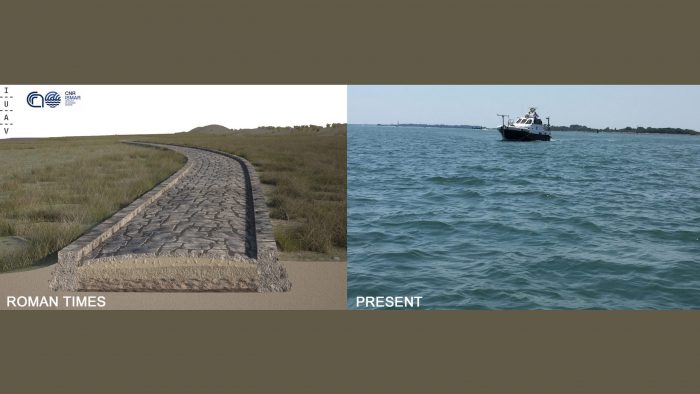Today, Venice is one of Italy's most beautiful cities—as well as one of the world's most, well, waterlogged.
Much of Venice's 'roads' are its many canals. (Getty Embed)
Lined with countless narrow canals, the tightly packed island city has a very close relationship with water. So much so, that its most well-known form of transportation isn't a car, or bicycle, or subway, it's these ...
A Venetian gondola, a traditional type of boat used much like a taxi or Uber in most cities. (Getty Embed)
But a new study is suggesting that Venice wasn't always so wet. Scans of the bed (or floor) of the lagoon to the north of the city show that there were once buildings down there. This includes the remains of a now-underwater road built by the Romans around 2,000 years ago. And if there's one place no one is going to build a road, it's underwater.
So this area must have once been dry land!
An unknown history

The researchers prepared this comparison of what the road may have looked like during the days of the Roman Empire alongside what it looks like today. (Reconstruction: Antonio Calandriello and Giuseppe D'Acunto; Photo: Fantina Madricardo)
Venice dates back to around the 7th century—about 1,400 years ago. But though it is a very old city, the history of the area before that time is not that well documented. This means that during the peak of the Roman Empire (over 2,000 years ago), we don't have much to go on when wondering what the area around Venice was like. The Romans controlled the general area, but did anyone live there? And where did they live?
Here is where this new study might be of help.
Putting together an old civilization

A map of the major highways built by the Roman Empire. (Wikimedia Commons)
The Romans were famous for their paved roads. This new innovation made transportation across their enormous empire possible. They built everything from local streets to long 'highways' that criss-crossed much of Europe and parts of Asia. Not only was it an incredible achievement, but the remains of an old Roman road is a sign that this was an area of importance to their empire.
This new study of the Treporti Channel north of Venice has revealed structures nearly 3 metres (9 feet) tall, and as long as 52 metres (170 feet). In other words, pretty significant buildings. They have found tiles, pottery, and other examples of civilization. And they have also found the remains of road, stretching across the seabed in long line.
Today, this water is not too deep—around 9 metres, or 30 feet, in places. And experts know that the water levels have been slowly rising for centuries (which is why Venice is the way it is today). In other words, it is very possible that much of the lagoon was once dry land.
More research is needed to properly date the area. But it is an interesting look at how an area can change over time!
 'Going our way?' A reconstruction of a Roman road. (Antonio Calandriello and Giuseppe D'Acunto)
'Going our way?' A reconstruction of a Roman road. (Antonio Calandriello and Giuseppe D'Acunto)









